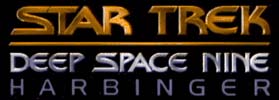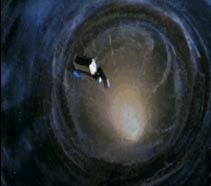
by



After Spectrum Holobyte with "Star Trek The Next Generation: A final Unity", Stormfront have been given the honor of creating a brand new Star Trek computer gaming adventure. Against all the appearances, Stormfront isn't a newcomer in the industry. Founded as "Beyond Software", the now Stormfront were responsible for titles such as "Tony La Rusa Baseball 3", "Old Time Baseball", "Madden NFL 96" (For EA Sports) and "ESPN Hockey Tonight" for Sony.
DS9 has always been labelled as a sci-fi soap opera, never really hitting the ratings of STTNG as the series tended to lack the action of the other Star Treks. Although recently within the series things are changing, it translates to quite a few headaches for the developers trying to generate an involving and interesting game.
In DS9 Harbinger you are Envoy Bannik, originally summoned to help enable a first contact meeting with a race from the cryptic Gamma quadrant whose inhabitants are known as the Scythians. The murder of the chief Ambassador and an unprovoked alien attack soon have you demonstrating your tactical, investigative and problem solving abilities to help defend the station from attackers both within and out.
Installing DS9 Harbinger is quite simple, but playing the game with the configuration however is a whole different story. After the files had been copied over, the standard configuration options menu appeared. In DS9, for optimized performance, you can select the chipset on your video card, or even have the software automatically select it for you. Thinking all to be fine and dandy after the installation, I started the game. The video played fine and things looked good. When the time came for some user interaction however, to my surprise I found the mouse moving erratically all over the screen. Several reboots and a few different mouse drivers later for some insane reason I decided to change the video driver to the standard VESA, which corrected the mouse problem.
Unfortunately, the nine page manual, besides lacking any content worthy of reading, failed to have a troubleshooting section. The README file also was useless in regard to this particular problem. With other games on the market that use the univbe standard for automatically configuring and enhancing video card speed, it seems a shame that Stormfront did not follow suit. I sincerely hope I was the odd one out with this problem else there are going to be some pretty angry customers calling for help desk support. My tip for this matter, use the auto-detect, if however, you encounter any problems, try to change the display type to VESA.
 |
| Exiting the Worm Hole |
Commander Sisco looks like a blow up doll with a goatee and a massive dent missing from part of his left chest. Dax looks like she has lost her breast in some bizarre trillian ritual and sufficed by shoving two tennis balls up there instead. Kira just doesn't really look like Kira and all the animations are mostly restricted to the mouth opening and closing to the dialogue. In fact, the only character that resembles its living counterpart is Odo, but considering all the make-up on Odo to make him polygonal in the TV series, to not have him looking similar, you'd be the laughing stock of the gaming industry.
Ultimately, I never felt comfortable seeing 3D representations of my favorite actors. I am not against the process of using 3D computer generated actors, but when it comes down to people you've watched repeatedly on TV I would rather have the real thing.
The station in DS9 has been faithfully re-created in 3D, which is undeniably an excellent use of the medium. Being able to walk around a 3D environment gives new life to a Star Trek adventure. Since Interplay released "Star Trek: 25th anniversary", the trend has been to use two dimensional back drops with cartoony sprites that wander around a flick screen world. In DS9, the procedure is very similar to that used in games such as "Myst".
The palette in DS9 is limited to 256 colors, and perhaps we are spoiled by the spate of 16 bit Hi-color games, 256 colors seems nowadays just satisfactory.
Much to my delight, DS9 uses the first person perspective. Moving the cursor around the screen, the icon changes to represent turning, moving forwards or backwards with your current view of the surrounding area brought up off the CD-ROM.
Speaking of the user interface though, the DS9 interface is really poor. Although more acceptable as you get used to it, the first time you encounter "ops" you have no idea where you are going. I found navigating ops to be unbelievably confusing. The icon that represents straight ahead becomes a curved arrow representative of Cardasian designs being round. This was meant to symbolize walking forward, however, moving the cursor a little too far brought up the turn icon. The confusion generated by the interface in this environment literally has you running in circles on the spot.
The sound in DS9 is very clear. In fact the intro sequence is a perfect sampling of the original TV series. So impressed was I, I plugged my headphones directly in the sound card to try and hear any little imperfections. Gladly, I can report that none were heard. A top effort by the sound team.
As can be expected, most of the voices from the series are directly sampled in the game. All dialogue is spoken by Sisko, Dax, Kira, Odo and Quark. Curiously enough though, Doctor Bashir and the Cardasian tailor are nowhere to be seen or heard in the game.
The game play in DS9 is unique to a Star Trek game and consists of two distinct parts: action and adventure. The action sections are very similar to games such as Rebel Assault, Wetlands, etc. It consists of fully animated cinematic backdrops with sprites overlayed over the top. Being taken on a set path, you have to destroy as many enemies as possible before they can fire at you. I normally don't like these types of games, but as one of the many contradictory emotions I have experienced in DS9 Harbinger, I really enjoyed the action sequences they have to offer.
To explain further, the sequence is severely flawed, the sprite detection is appalling with many of your hits just not being registered. To take aim you have to use the mouse, which is more welcome than a joystick, but the movement is erratic and often overshooting your target. The minute corrections that need to be made just don't tend to happen. Using two hands to hold the mouse helped, but the control just never seemed to be there.
For some reasons however, the process never frustrated me. Despite the flaws, there was something extremely enjoyable about buzzing around the DS9 station blowing away the mysterious drones. Perhaps it was hearing Sisko's and Dax's voice giving target updates, the sense of urgency generated by the computer reporting damage to a bulkhead, or it was maybe the sheer beauty of the sequence. DS9 has all its action sequences rendered in SVGA, using a good 2/3rds of the screen. The graphics are very detailed, with no decompression scars seen in many video scenes to date.
The playability of the game is fine. The system automatically saves your game before an action sequence, and you can generally get through them after three or four tries. If it gets all too hard, you can reduce the difficulty level before starting again.
The adventuring side is also rather different to your mainstream adventure game. The first thing that struck my attention was the lack of inventory. In DS9, you don't need to have the right object in the right place at the right time. What you do need to have though, is the correct information. Moving from place to place, you have to ask people the proper questions in order to dig up information relevant to your quest, which initially is finding out who killed Ambassador Karrig. There are rare moments where you do pick up items like a phaser or cloaking device, but their use is restricted purely to the relevant time. No choice is made on your behalf as to when to use it.
There are also rare moments where a puzzle similar to those present in "The Seventh Guest" have to be solved, taking the form of a broken plasma relay or on board circuit. Pieces have to be manipulated in the right order to repair the device. None of the problems are particularly taxing, but entertaining in their own right. At the very least they provide some more variance to the game.
In all I found the process refreshingly interesting. Not having to worry about clicking on every nook and cranny to find an obscure key to gain entrance to a new point, the game focuses more on your ability as an envoy (Ambassador in training) to resolve situations verbally. It also allows you to concentrate more on the story in the game, which in a way is extremely entertaining. Actually I have even found it to be more interesting than many of the DS9 television episodes.
As you progress in the game, eventually you go to the Gamma quadrant and take on an evil ancient robotics factory that produces nothing but ships of destruction. Crashing inside the factory, you have to walk around the complex, switching machines on or off to create the desired effect in order to contact DS9 for a rescue.
This particular area is akin to a maze, with the unwelcome element of action sequences inflicting themselves randomly upon you. When wandering aimlessly, trying to pre-empt your next move, a random drone will scroll across the screen, and if you don't shoot him fast enough, only one shot from him will kill you. Switching to a lower level also does nothing to help your situation. With the automatic save game doing nothing before an attack, it leaves you extremely frustrated as you have to start from whence you last saved. With over 350Kb per save game, I just have to wonder what Stormfront were thinking.
The action sequences are not impossible, the puzzles logically solvable and the graphics consistent with that of the series. DS9 Harbinger is a welcome addition to the Star Trek based games and definitely in the right direction for games to come. Adding this title to your software collection would not be a bad choice at all.
Written by Jere Lawrence
| Graphics: | 75% |
| Sound: | 70% |
| Music: | 95% |
| Gameplay: | 90% |
| Interest: | 90% |
| Overall: | 85% |
Sound Blaster or 100% compatible sound cards.
Viacom NewMedia.,
1515 Broadway,
New-York, NY 10036.
Web site: Viacom NewMedia
In Europe:
In UK:
CIC Interactive,
c/o PO BOX 63,
Hartlepool,
Cleveland, TS25 2YP.
| Technical Support: | 0800-371314 |
In Germany:
CIC GMBH,
Stutzelackerweg 12-14,
6000 Frankfurt/M90.
| Technical Support: | 0130-820115 |
In France:
CIC SNC,
1 Rue du Petit Clamart,
78140 Velizy Villacoublay.
| Technical Support: | 0590-8318 |
In Italy:
CIC S.R.L.,
Via A. Cechov,
20151 Milan.
| Technical Support: | 1678-71975 |
In Spain:
CIC Y CIA, SRC,
Albacete 5-3 Planta Edificio AGF,
28027 Madrid.
| Technical Support: | 900-994433 |
In Netherlands:
CIC,
Ampereweg 13,
3442 AB Woerden.
In Sweden:
CIC,
Lilla Bommen 1,
41104 Goteborg.

Copyright © 1996 Coming Soon Magazine, Inc. All Rights Reserved.
Reproduction in whole or in part, in any form or medium without express
written permission of Coming Soon Magazine is prohibited.